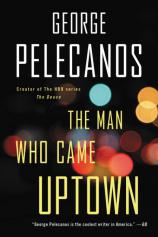The Man Who Came Uptown
Review
The Man Who Came Uptown
I would hope that those who enjoy the screen work of George Pelecanos also seek out each and every book that he writes. His screenplays have been seen on “The Wire,” “Treme,” “The Deuce” and the beautifully realized but woefully ignored miniseries “The Pacific.” But of arguably greater import is that Pelecanos has crafted 21 novels, most of them being crime fiction set in Washington, D.C. of the past and present. He eschews political correctness in his work in favor of keeping his characters, plotlines and dialogue real. The folks who populate his books are usually never all good or all bad. They reveal their natures in a series of situations, passing through each until they reach their individual conclusions, which rarely produce a zero-sum.
Pelecanos’ newly published THE MAN WHO CAME UPTOWN is a stand-alone work that cinematically unfolds in equal parts beauty and violence. It primarily follows three separate and very different characters. Michael Hudson is the “Man” of the title. When we meet Michael, he has been incarcerated for several years due to his involvement in a Washington, DC robbery. He fills his long and otherwise non-productive days with reading, an activity that he did not engage in much on the outside but now finds he enjoys. The major reason for that is Anna Kaplan, the mobile librarian of the DC jail. Anna tailors the reading selections to the patrons, finding books that match their interests with an equal balance of quality and clarity. Michael makes a point of reading each of her recommendations and immediately selecting another book.
"[THE MAN WHO CAME UPTOWN] contains some of [George Pelecanos'] best writing to date in any media."
Then comes his abrupt release from jail thanks to the mechanizations of a local private investigator named Phil Ornazian, who supplements his public income by occasionally knocking over local pimps and drug dealers. Michael finds that his former outside environs has changed considerably in the several years that have passed during his incarceration. The seedy bars, check-cashing stores and phone outlets have given way to gentrification. Michael has it better than many in his situation, given that he has the support of his mother, who has been the rock of the family in good times and bad. He is also able (through contacts) to obtain entry-level employment. It is Michael himself, though, who ultimately does the heavy lifting of readjustment to lawful work and living on a day-to-day basis.
That changes when Ornazian approaches him, seeking payback for his efforts that resulted in Michael’s successful release. The work is not legal --- Ornazian wants to use Michael as a driver on his heists and threatens to quickly upend what he has accomplished --- but it is better to have Ornazian on his side while on the street rather than against him. However, at roughly the same time, Michael and Anna have a chance encounter that leads to coffee and a bookstore jaunt, and the possibility of something more, which poses complications for both of them, especially for Anna. There are a number of quiet twists and turns that play out all the way to the book’s satisfying, somewhat bittersweet ending.
THE MAN WHO CAME UPTOWN may or may not become your favorite Pelecanos novel. What is undeniable is that it contains some of his best writing to date in any media. Michael, Anna and (to some degree) Ornazian will haunt you, for all the right reasons, long after the story reaches its end. Pelecanos also provides a bit of lagniappe in the form of a de facto reading list through Anna’s recommendations, consisting of some books you may have read and others you have not. All are worthwhile, as is this one.
Reviewed by Joe Hartlaub on September 7, 2018
The Man Who Came Uptown
- Publication Date: September 10, 2019
- Genres: Fiction, Hard-boiled Crime Fiction, Suspense, Thriller
- Paperback: 272 pages
- Publisher: Mulholland Books
- ISBN-10: 0316479837
- ISBN-13: 9780316479837




